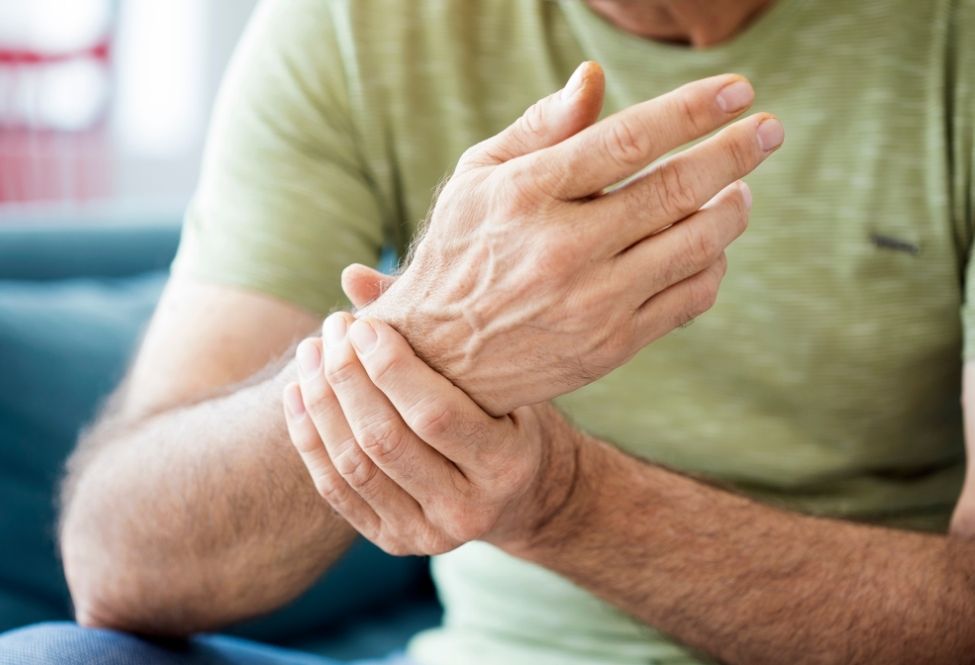We all connect rheumatism to older generations which is not necessarily the case. People of all ages, even children, can have rheumatism. Not many people know that rheumatism consists of more than 200 diseases, however, they’re all connected. They all attack our musculoskeletal system, bones, cartilage, joints, tendons, ligaments, and muscles. We can also split it into two categories, them being inflammatory and non-inflammatory. Some of the most common symptoms of having rheumatism are pain in the joints, the back, tendons, fatigue, and more. We can divide the treatment into two options, drug and non-drug treatments.
If you want to learn more, keep reading the article by Dr. Jocelyne Melchior-Capiot.
“Rheumatism…??? But that’s something for old people!…”, one of my younger patients tells me when I announce to her that a rheumatic disease is the cause of her pain. She has been suffering from pain in her back and knees for 5 years.
Exactly not! Rheumatism is not reserved for our elderly fellow citizens… Younger adults, children, middle-aged people can also be affected, men as well as women.
In Switzerland, there are 2 million inhabitants suffering from rheumatism, 300,000 of whom have chronic, more severe cases that can cause functional disability. The economic aspect: rheumatism costs billions. Direct costs (various necessary treatments), indirect costs (related to loss of work, disability pensions), but above all human costs in terms of physical and mental suffering, which entails a reduction in quality of life. Fortunately, new treatments have been available for about 20 years, revolutionising the practice of rheumatology and improving the daily lives of our patients.
WHAT IS RHEUMATISM?
The word comes etymologically from the ancient Greek “rheuma”, it means “flowing water”, because in ancient times rheumatism was considered as the “flowing off of the (bodily) juices” of the human body, because of the pain symptoms that “flow out” in the course of the disease in different regions of the body. Rheumatism is a general term that includes more than 200 diseases with a common aspect: it attacks the musculoskeletal system, bones, cartilage, joints, tendons, ligaments, muscles. Rheumatic diseases can be divided into two broad categories: inflammatory and non-inflammatory rheumatism.
Inflammatory rheumatism includes:
- The various forms of arthritis, inflammation of the joints of different origins: infectious arthritis (bacterial or viral), arthritis due to auto-immune disease, such as in rheumatoid polyarthritis.
- Diseases caused by spondyloarthritis (inflammation of the spine and periarticular zones), such as ankylosing spondyloarthritis (Bekhterev’s disease).
- Collagenoses or tissue diseases affecting the connective tissue in the musculoskeletal system (lupus, Sjögren’s syndrome, scleroderma, myositis), with immunological problems.
Non-inflammatory rheumatism includes:
- Osteoarthritis (wear and tear disease), diseases that affect the joints but also the spine and cause chronic pain.
- Microcrystalline arthropathies, such as gout or pseudogout (chondrocalcinosis), caused by crystalline deposits in the joints.
- Bone diseases such as osteoporosis, osteomalacia.
- Metabolic soft tissue diseases (calcification of the ligaments), overloaded joints, disturbed pain reactions (fibromyalgia).
WHAT ARE THE SYMPTOMS OF RHEUMATISM?
Rheumatism is manifested by pain:
- in the joints (hands, feet, knees, elbows…)
- in the back (cervical, thoracic and lumbar spine)
- pelvis, buttocks, ribs, sternum
- tendons (Achilles tendon, elbows, wrists, ankles…)
- Swelling (effusions) in the joints or surrounding regions, sometimes with a feeling of heat due to inflammation.
- Stiffness, especially in inflammatory rheumatism, which requires flexibility exercises, especially in the morning. This can restrict movement and be a major hindrance to daily activities.
- Deformation of certain parts of the skeleton, depending on the type and development of the rheumatism.
- Extreme fatigue, in inflammatory rheumatism a sign of the unusual strain on the immune system.
WHAT ARE THE CAUSES OF INFLAMMATORY RHEUMATISM?
The exact causes of rheumatism are not yet known, but it is known that environmental influences play a role and, together with certain genetic factors, influence the appearance and course of the disease.
Inflammatory rheumatism consists in auto-immune diseases: instead of defending the organism against external “enemies” (viruses, bacteria), the disturbed immune system no longer recognises its own organism as such. Thus, it attacks its own body through complex reactions and the autoantibodies produced, causing inflammatory chain reactions that lead to local or systemic inflammatory processes.
Depending on the course of the disease, the inflammation can damage the tissue around the skeleton and cause deformities of the joints for a long time. This development is not predictable, and can sometimes be related to stress factors. Very painful periods of joint disease progression may alternate with pain-free remission periods, between relapses.
HOW IS IT DIAGNOSED?
Through a detailed discussion with the patient and after a complete medical check-up, the rheumatologist will first make a hypothesis, which he will then clarify through additional examinations:
- Laboratory tests
- Possibly joint puncture
- X-rays
- If necessary ultrasound, computer tomogram, magnetic resonance imaging.
WHAT ARE THE MAIN TYPES OF INFLAMMATORY RHEUMATISM?
There are 3 main types:
● Rheumatoid polyarthritis
● Ankylosing spondyloarthritis
● Psoriatic arthritis
1. Rheumatoid polyarthritis
The most common form of chronic inflammatory rheumatism affects about 0.4% of the population. The first symptoms appear between 40 and 50 years of age and mainly affect women (women are affected three times as often as men). If the disease starts before 15 years of age, it is called chronic juvenile arthritis. Rheumatoid polyarthritis affects several joints, often symmetrically, and develops in a few weeks.
Due to the immune dysregulation, antibodies are produced (rheumatoid factor, autoantibodies against cyclic citrullinated peptide – CCP), which trigger severe inflammation in the joints with thickening of the synovial membrane and more production of inflamed synovial fluid. This immigration of defence cells and the proliferation of connective tissue-forming cells results in “pannus” – a proliferating tissue that can destroy the cartilage and surrounding tissue. Rheumatoid polyarthritis often progresses in episodes with pain and joint swelling, pain at night and stiffness in the morning. The diagnosis is made on the basis of examination of the patient, with laboratory tests (blood sedimentation, C-reactive protein, immunological blood values) and medical imaging. If the X-rays are initially normal, an early diagnosis can be made by ultrasound and MRI.
2. Ankylosierende Spondyloarthritis (Morbus Bechterew)
Entzündlicher Rheumatismus, von dem häufig jüngere Erwachsene betroffen sind, manchmal vor dem 40. Alter des Auftretens. Die entzündliche Erkrankung befällt das Becken und die Wirbelsäule sowie die Sehnenansätze, anatomische Zonen und das Rückenmark. Sehnenansätze, anatomische Zonen, an denen Sehnen am Knochen ansetzen.
Pain occurs in the area of the sacroiliac joints (joints between the sacrum and the pelvis), where the ligaments and joints hold the vertebrae together, but also in the chest. The external tendon insertions can also be affected (Achilles tendon, heel, elbow, knee, hips…). Rapid fatigue, lumbalgia, pain in the buttocks, mid-back, pelvis, with a nocturnal rhythm and morning stiffness are typical signs of this diagnosis. At the same time, there may be other inflammatory diseases affecting the skin (psoriasis), the eye (uveitis), the intestinal tract (Crohn’s disease, ulcerative colitis).
Laboratory tests rarely show the signs of inflammation as in rheumatoid polyarthritis. The clustering of the histocompatibility antigen HLA-B27 (tissue compatibility) is more significant than in the general population, but is not positive in all patients and is therefore not specific.
X-rays of the spine and pelvis can provide informative images in sacroiliitis (sacroiliac joints, joints between the sacrum and ilium). Here, too, an early diagnosis can be made by MRI.
3. Psoriatic arthritis
Inflammatory rheumatism in the milieu of a skin disease: psoriasis affects women and men alike, often between 30 and 50 years of age. One form affects the joints in the back and pelvis, making it similar to spondyloarthritis, or the peripheral joints (as in polyarthritis), or mixed forms affecting the back and joints. In contrast to polyarthritis, the affection is asymmetrical, initially confined to one or two joints and/or the hand.
Again, pain, swelling and morning stiffness are symptomatic. The main clinical diagnosis is made by examination by the doctor; the characteristic skin changes are scaly, whitish, reddish and yellowish, and/or reddish, often on the knees, behind the elbows, on the scalp. Infestation of the nails may also be characteristic. A blood test may show inflammatory markers, and X-rays typical changes.
HOW IS RHEUMATISM TREATED?
Therapeutic care for the rheumatism patient is multi-faceted: first, the pain must be reduced and the best possible quality of life must be offered, together with psychological care during treatment.
Likewise, stiffening and joint deformation must be prevented so that the affected patient maintains his physical independence.
Treatment revolves around 2 axes: drug and non-drug therapy.
1. Drug therapy
Symptomatic treatment aims to decrease pain and inflammatory processes. These are analgesics (paracetamol, tramadol, sometimes morphine) and steroidal or non-steroidal anti-inflammatory drugs (orally administered cortisone, intra-muscularly or via infiltration). However, this does not address the immune problem of rheumatism.
The basic treatment fights the dysfunctional immune system mechanisms responsible for the development of inflammatory rheumatism and can thus slow down or even stop the course of the disease. These treatments tackle the disease at its root. This requires a latency period of 4 to 12 weeks to assess effectiveness. Not without side effects, this form of treatment must be strictly supervised by a medical specialist. A distinction is made between chemical and biological or biotherapeutic basic treatments.
The most widely used basic chemical treatment for 30 years is methotrexate. Originally developed as a cancer drug, it is used in rheumatology in very small doses, once a week, in tablet form or as a subcutaneous injection. Other molecules such as sulfasalazine, leflunomide or hydroxychloroquine are also used, alone or in combination with other drugs.
Biological or biotherapeutic basic treatment is carried out with molecules produced by cells. It works alone or in combination with basic chemical treatment and is successful in 60 to 80% of all cases. It is used when conventional chemical treatments do not work and there is no contraindication. It can lead to the disappearance of the symptoms. The disadvantage of this treatment is its possible tendency to promote infections and must therefore be monitored very closely. The patient should be adequately informed and have a complete check-up beforehand (examine teeth, vaccination status, blood values).
The biotherapies have several targets. The TNF alpha blockers regulate the proteins of the immune system (TNF alpha) or the interleukins (IL1/IL6/IL17). There are, among others, the following TNF alpha blockers: infliximab, etanercept, adalimumab, certolizumab, golimumab.
Tocilizumab is a so-called IL-6 receptor blocker, interleukin 6 is a substance that plays a major role in inflammatory processes. Anakinra blocks interleukin 1 and Secukinumab blocks interleukin 17.
Another molecules act on the cells of the immune system: Rituximab switches off the B-lymphocytes and Abatacept curbs the activation of the T-lymphocytes, important cells in the immune response.




2. Non-drug treatments
Physiotherapy is indispensable to relieve pain, maintain mobility and prevent deformities of the joints or spine. Different therapy approaches are possible: massages, mobilisation exercises, stretching exercises, elec-trotherapy, PST pulsating signal therapy, mobilisation exercises in the swimming pool. Anything that gently promotes mobility is recommended, with consideration for the level of pain (gentle gymnastics, Taï-Chi, yoga). Mindfulness-Based Stress Reduction (MBSR), and hypnosis also play a major role in anti-algia. Complementary helpful approaches are acupuncture, phytotherapy, mesotherapy.
For the functions of daily living with minimal stress, assessment and treatment by an occupational therapist, in some cases at home, can be a useful measure. Sometimes it is necessary to use an orthosis to relieve and/or stabilise a suffering joint.
So the rheumatologist is the conductor of the treatment orchestra for the rheumatic patient, the therapeutic vision is necessarily interdisciplinary, considering the complexity and diversity of musculoskeletal disorders with rheumatism. The patient needs clear and precise information, what is called “patient information (patient education)”, it is carried out by the doctor and with the intervention of a specialised nurse.
In harmonious collaboration with the attending physician, a treatment plan is actively developed in which the patient plays a participatory role, together with those close to him. This is as important as respecting the patient’s autonomy in decision-making.










